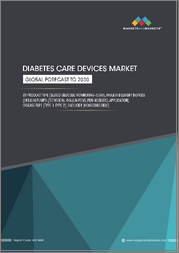
|
시장보고서
상품코드
1532316
커넥티드 당뇨병 케어 : 혁신과 성장 기회Connected Diabetes Care: Innovations and Growth Opportunities |
||||||
연속 혈당 모니터링, 인공 췌장 시스템, 신규 인슐린 제제가 당뇨병 관리의 미래를 변화
손가락 채혈 혈당 측정 대신 웨어러블 CGM을 이용한 당뇨병 자가 평가에 대한 선호도가 특히 1형 당뇨병 환자(T1D)에서 증가하고 있습니다. 현재 HbA1c와 TIR은 당뇨병 모니터링 용도에서 선호되는 바이오마커입니다. 새로운 다이어트/피트니스 추적 앱은 전반적인 건강을 지원하고 당뇨병과 같은 생활습관병의 발병을 예방하는 데 도움이 될 수 있습니다. 고급 인공지능(AI)을 사용하여 혈당 수치 예측을 포함한 생리적 지표에 대한 예측적 인사이트을 제공함으로써 이러한 앱의 예측 기능을 가능하게 했습니다.2형 당뇨병(T2D)에 대한 기존의 처방약은 경구용 약물로 구성되어 있습니다. 그럼에도 불구하고 T2D 관리, 특히 경구용 약물로 혈당을 조절할 수 없는 환자들을 위한 인슐린 사용이 증가하고 있습니다. 인슐린은 인슐린 전달 플랫폼의 지속적인 발전으로 T1D 환자 치료의 주역이 되고 있습니다.
하이브리드 폐쇄 루프 시스템 또는 인공 췌장은 T1D를 최적으로 관리하기 위한 선호되는 치료 옵션으로 빠르게 부상하고 있습니다. 이러한 시스템은 일반적으로 CGM, 인슐린 펌프, 혈당치를 지속적으로 관리하기 위한 모니터링 및 전달 플랫폼 간의 교류를 용이하게 하는 고급 알고리즘으로 구성됩니다. 스마트폰 앱로 연결된 웨어러블 모니터링 기기의 사용이 증가함에 따라 당뇨병 관리를 개선하기 위한 앱 기반의 개인화된 추천과 실용적인 예측적 인사이트가 가능해지면서 디지털 치료의 발전으로 이어지고 있습니다. 이 보고서는 CGM, 인슐린 전달 기술, 인공 췌장의 발전에 대한 인사이트을 제공합니다. 또한 세계 당뇨병 치료의 미래를 좌우할 자금 조달, 새로운 디지털 당뇨병 치료 기술 및 파트너십에 대한 분석도 제공합니다.
목차
당뇨병 케어 부문의 트랜스포메이션
- 왜 성장이 어려워지고 있는가?
- The Strategic Imperative 8(TM)
- 커넥티드 당뇨병 케어 업계에 대한 주요 전략적 필수 요건의 영향
- Growth Pipeline Engine(TM)을 촉진하는 성장 기회
- 조사 방법
성장 기회 분석
- 당뇨병의 유병률과 관련 건강 리스크의 개요
- 디지털 당뇨병 케어의 현황
- 분석 범위
- 세분화
성장 제너레이터
- 성장 촉진요인
- 성장 억제요인
글루코오스 모니터링 기술
- 웨어러블 CGM의 개요
- CGM 상황의 현황
- CGM과 관련 앱 분석
- 새로운 CGM 혁신
- 주요 요점과 전망
HCL 인슐린 전달 시스템
- HCL 인슐린 전달 시스템의 개요
- 인공 췌장 상황의 현황
- 인공 췌장 시스템과 관련 앱 분석
- HCL 상황 새로운 혁신
- 주요 요점과 전망
인슐린 전달 기술
- 인슐린 전달 기술의 개요
- 인슐린 전달의 경쟁 상황의 현황
- 인슐린 전달의 최근/향후 혁신
- 주요 요점과 전망
자금조달, 파트너십, 인수
- 자금조달 분석
- 주요 파트너십과 인수
- 당뇨병 케어 - 전망
성장 기회 유니버스
- 성장 기회 1 : 비침습적 커넥티드 글루코오스 센서
- 성장 기회 2 : 소형 웨어러블 인공 췌장
- 성장 기회 3 : 경구 인슐린
다음 스텝
KSA 24.08.27Continuous Glucose Monitoring, Artificial Pancreas Systems, and Novel Insulin Delivery Formulations to Transform the Future of Diabetes Management
The preference for diabetes self-assessment using wearable CGMs instead of finger-stick blood sugar testing is increasing, especially in type 1 diabetics (T1D). HbA1c and time-in-range are currently the preferred biomarkers for diabetes monitoring applications. Emerging diet and fitness tracking apps help support general well-being and prevent the onset of lifestyle diseases such as diabetes. The use of advanced artificial intelligence (AI) has enabled the predictive capabilities of these apps by providing predictive insights on physiological markers, including the prediction of blood glucose levels. Conventional prescription medications for type 2 diabetes (T2D) comprise oral drugs. Still, there is a rising use of insulin for T2D management, especially for patients who are unable to manage blood sugar levels with oral medicines. Insulin continues to be a mainstay for treating T1D patients, with continuous advances in insulin delivery platforms.
Hybrid closed-loop systems or artificial pancreas are fast emerging as a preferred treatment option for optimally managing T1D. These systems typically comprise a CGM, an insulin pump, and an advanced algorithm that facilitates cross talk between the monitoring and delivery platforms for managing blood sugar levels continuously. The rising use of wearable monitoring devices connected through smartphone apps has enabled several app-based personalized recommendations and actionable predictive insights for improved diabetes management, leading to digital therapeutics development. This research provides insights into advancements in CGMs, insulin delivery technologies, and artificial pancreas. The study also analyzes funding, emerging digital diabetes care technologies, and partnerships shaping the future of global diabetes care.
The study answers the following questions: What are the key technological advancements in CGM devices and insulin delivery platforms? Who are the key innovators across device-based diabetes care platforms? How are funding and partnership trends likely to impact the diabetes care device industry? What are the emerging trends for digital diabetes care? What are the growth opportunities for digital diabetes management?
Table of Contents
Transformation in the Diabetes Care Sector
- Why Is It Increasingly Difficult to Grow?
- The Strategic Imperative 8™
- The Impact of the Top 3 Strategic Imperatives on the Connected Diabetes Care Industry
- Growth Opportunities Fuel the Growth Pipeline Engine™
- Research Methodology
Growth Opportunity Analysis
- Overview of Diabetes Prevalence and Associated Health Risks
- Snapshot of Digital Diabetes Care
- Scope of Analysis
- Segmentation
Growth Generator
- Growth Drivers
- Growth Restraints
Glucose Monitoring Technologies
- Overview of Wearable CGMs
- Snapshot of the CGM Landscape
- Analysis of CGMs and Related Apps
- Emerging CGM Innovations
- Key Takeaways and Outlook
HCL Insulin Delivery Systems
- Overview of HCL Insulin Delivery Systems
- Snapshot of the Artificial Pancreas Landscape
- Analysis of Artificial Pancreas Systems and Related Apps
- Emerging Innovations Across the HCL Landscape
- Key Takeaways and Outlook
Insulin Delivery Technologies
- Overview of Insulin Delivery Technologies
- Snapshot of the Competitive Landscape for Insulin Delivery
- Recent and Upcoming Insulin Delivery Innovations
- Key Takeaways and Outlook
Funding, Partnerships & Acquisitions
- Funding Analysis
- Key Partnerships and Acquisitions
- Diabetes Care-Outlook
Growth Opportunity Universe
- Growth Opportunity 1: Noninvasive Connected Glucose Sensors
- Growth Opportunity 2: Miniaturized Wearable Artificial Pancreas
- Growth Opportunity 3: Oral Insulin
Next Steps
- Benefits and Impacts of Growth Opportunities
- Next Steps
- Take the Next Step
- Legal Disclaimer



















